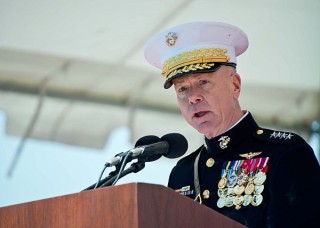
“We are not sure how that is going to play out,” the commandant of the U.S. Marine Corps said about events in Afghanistan and Pakistan as the United States and NATO complete their withdrawal from combat operations in 2014 as he launched into an around the globe assessment of threats from North Korea’s “no sense of stability” to pirates in the Gulf of Aden and the Straits of Malacca facing the nation now.
Gen. James Amos, speaking Monday at the Navy League’s Sea-Air-Space Exposition 2013 at National Harbor, Md., said that it was important that the Marine Corps return to its expeditionary roots. “Actually, presence matters, we [the sea services, particularly] are the stabilizing force” to “build partnership, built trust” in a region. “You can’t surge trust.”
With the Marine Corps and Navy down to 7,000 service members in Afghanistan, down from 20,000 a year ago, the “advantages of naval forces are they can be forward deployed… That is their raison d’etre.”
Amos, the first aviator to be named commandant, that forward deployment and power projection based on the range of the F-35B Lightning and MV-22 Osprey would be enhanced with the commissioning of America (LHA-6) later this year, and LHA-7, already laid down. They “will be built without well decks” so more aircraft can be put aboard the ship. He called the V-22 Osprey “a game changer” that “several other countries are looking at buying it.”
LHA-8 will see the return of the well deck, but with a smaller island “to give it six more parking spaces” on its flight deck, Amos said.
The 11 San Antonio-class LPDs, starting with Arlington commissioned April 6, will be the need replacements for the Whidbey Island-class LSD, Amos said. Gen. John Paxton, assistant commandant speaking Tuesday, said the Navy and Marine Corps are trying to return to 32 or 33 large hulled amphibious vessels. “We’re working through this. We cannot walk away from using other vessels to deploy, lighter skin vessels,” such as prepositioning ships and the Joint High Speed Vessel. The Marine Corps “is still in desperate need of amphibs.”
Looking at his largest cost, Amos said that 64 percent of the Marine Corps budget goes to personnel – pay, housing, health care and other entitlements. When the Defense Department and the services asked for increased fees for the TRICARE health program, a commission to review future retirement benefits and new rounds of base closing, he said, “Quite honestly, they did not see the light of day in Congress.”
On issues like retirement, it was not the intention to “muck around” with “any benefit for people who earned them.” They would be grandfathered.
These requests again would be included in the Fiscal Year 2014 budget that heads to Congress April 10.
Paxton said that the Marine Corps would remain a young, first-term force in the future, requiring 32,000 to 35,000 recruits annually. Regarding manpower needs in the future, “we have to think of youth and experience and turnover” in shaping the force as it comes down to 182,100 in a few years from 203,000 in 2007. “We didn’t want to come down as fast we came up,” but “we’re coming down a little further and a little faster than we wanted.” He said the Marine Corps had wanted an end strength of 186000.
In answer to a question, Amos said that there are other factors raising costs. When the fighting in Afghanistan began in October 2001, the cost of outfitting a Marine for combat was $1700. It now costs $10,000 to outfit a Marine. “Body armor ceramics cost around $4000,” but these costs are necessary to save lives in carrying out missions.
Fiscal austerity extends into acquisition, and he expects it to last for six or seven years. Amos said that he is telling Marines, “We are going to have to live with equipment, but there has to be a balance [to allow] modernization,” such as the F-35 and MV-22.





